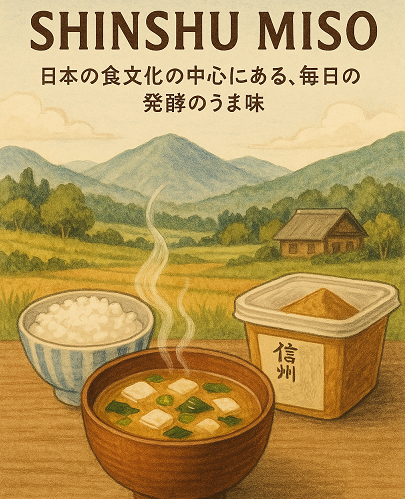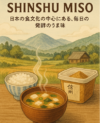
For many Japanese people, the comforting aroma of miso soup at breakfast is a nostalgic reminder of home. Miso—fermented soybean paste—is more than just an ingredient; it’s a cultural staple that has been part of Japanese daily life for centuries. Among the many regional varieties of miso, Shinshu Miso from Nagano Prefecture stands out as one of the most widely loved and widely used.
A Daily Essential in Japanese Homes
Whether it’s a simple bowl of miso soup or a marinade for grilled fish, miso finds its way into countless dishes across Japan. It’s salty, savory, and deeply umami-rich. Because of its versatility, miso is often seen as a symbol of everyday Japanese home cooking. Every household may have its own favorite type, and the flavor can even evoke memories of a mother’s cooking or a childhood meal.
A Rich Variety of Regional Flavors
Japan is home to a broad spectrum of miso types, each tied to specific regions and traditions. Some are dark and intense like Hatcho Miso from Aichi, while others are sweet and light like Saikyo Miso from Kyoto. Shinshu Miso, however, occupies a comfortable middle ground, making it a go-to choice in homes and restaurants across the country.
Why Shinshu Miso?
Originating in the mountainous region of Nagano, Shinshu Miso is made primarily from soybeans, rice koji (a fermenting agent), and salt. It typically has a light yellow color and a balanced, mellow flavor. This makes it suitable not only for traditional soups but also for dressings, stir-fries, and even Western-style dishes.
Its approachable taste reflects the warmth and simplicity of the people of Nagano—a region known for its rural charm and deep-rooted traditions. Just like the locals, Shinshu Miso is modest, dependable, and quietly flavorful.
A Modern Superfood
In recent years, the global trend toward fermented foods has brought renewed attention to miso. Packed with probiotics and nutrients, miso is now recognized as a “superfood” by health-conscious eaters around the world. Younger generations in Japan are rediscovering its benefits, incorporating it into smoothies, vegan dishes, and even desserts.
信州味噌:日本の食文化の中心にある、毎日の発酵のうま味
多くの日本人にとって、朝食の味噌汁から立ちのぼる香ばしい香りは、「家の味」として心に残る懐かしい記憶のひとつです。味噌(発酵した大豆のペースト)は、単なる調味料ではなく、何世紀にもわたって日本人の暮らしに深く根付いてきた食文化の基本です。その中でも、長野県発祥の「信州味噌」は、最も広く親しまれ、使われている味噌のひとつです。
日本の家庭に欠かせない毎日の味
味噌汁はもちろん、焼き魚の漬け床、炒め物や煮物の隠し味としてなど、味噌は日本のあらゆる料理に登場します。しょっぱくて、コクがあり、深い旨味が特徴です。味噌はその万能性から、日本の家庭料理を象徴する存在ともいえるでしょう。家庭ごとにお気に入りの味噌があり、味噌の香りが「おふくろの味」や「子どもの頃の食卓」を思い出させてくれることも少なくありません。
地域ごとに異なる個性豊かな味噌たち
日本各地には、その土地の風土や文化に根差した、さまざまな種類の味噌があります。たとえば、愛知の「八丁味噌」は濃くて力強く、京都の「西京味噌」は甘くてまろやかです。そんな中で信州味噌は、味の濃さとやさしさのバランスが取れた“中庸”の存在として、全国で多くの人に愛されています。
なぜ信州味噌が人気なのか?
山に囲まれた自然豊かな長野県で生まれた信州味噌は、大豆、米麹、塩を原料とし、やや淡い黄色をした味噌です。クセがなく、まろやかで親しみやすい味わいは、味噌汁だけでなく、ドレッシング、炒め物、洋風料理にもよく合います。
その控えめで飾らない味わいは、素朴で温かみのある信州人の気質とも重なります。静かに、でもしっかりと存在感を放つ味。それが信州味噌の魅力です。
今、味噌が“モダン”なスーパーフードに
近年、世界的な発酵食品ブームの中で、味噌も健康志向の食材として再評価されています。乳酸菌や栄養素が豊富で、体に優しい食品として、海外でも「スーパーフード」として注目されています。日本国内でも若者たちがその魅力を再発見し、スムージーやヴィーガン料理、さらにはスイーツにも味噌を取り入れる動きが広がっています。
